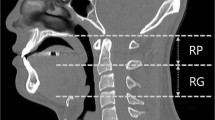Abstract.
The aim of this study was to assess the upper airway status of sleep apnea syndrome (SAS) patients with low-field MR fluoroscopy. Twenty patients with clinically diagnosed SAS underwent upper airway monitoring using MR fluoroscopy for 5 min while awake and for 30 min while asleep. A 0.064-T permanent-magnet MR imaging system was used for the study. No patients required any sedative drugs because of the very small gradient noise, except in one case. No occlusion was observed while patients were awake. Nine patients showed repeated occlusion at retropalatal (Rp) pharynx, whereas 11 demonstrated both simple Rp occlusion and combined retropalato–retroglossal (Rp + Rg) occlusions (complex occlusion). The mean frequency of occlusion in complex cases was significantly higher than that in simple Rp cases (p < 0.05). Low-field MR fluoroscopy was useful in determining the occlusion level while asleep in patients with SAS because of its quiet gantry and long-term monitoring capability. The MR fluoroscopy technique should prove to be a valuable clinical tool for the diagnosis and for determining the appropriate therapy in patients with SAS.
Similar content being viewed by others
Author information
Authors and Affiliations
Additional information
Received: 5 June 1998; Revision received: 30 November 1998; Accepted: 1 December 1998
Rights and permissions
About this article
Cite this article
Yoshida, K., Fukatsu, H., Ando, Y. et al. Evaluation of sleep apnea syndrome with low-field magnetic resonance fluoroscopy. Eur Radiol 9, 1197–1202 (1999). https://doi.org/10.1007/s003300050816
Issue Date:
DOI: https://doi.org/10.1007/s003300050816




